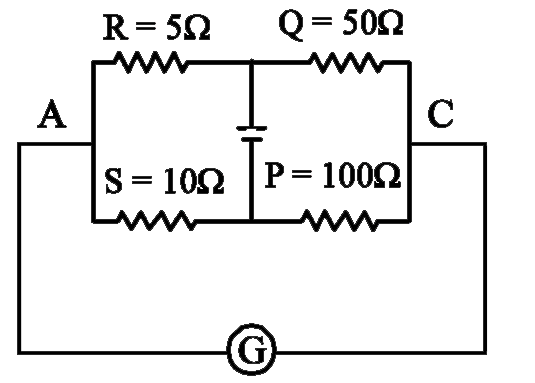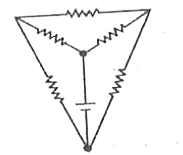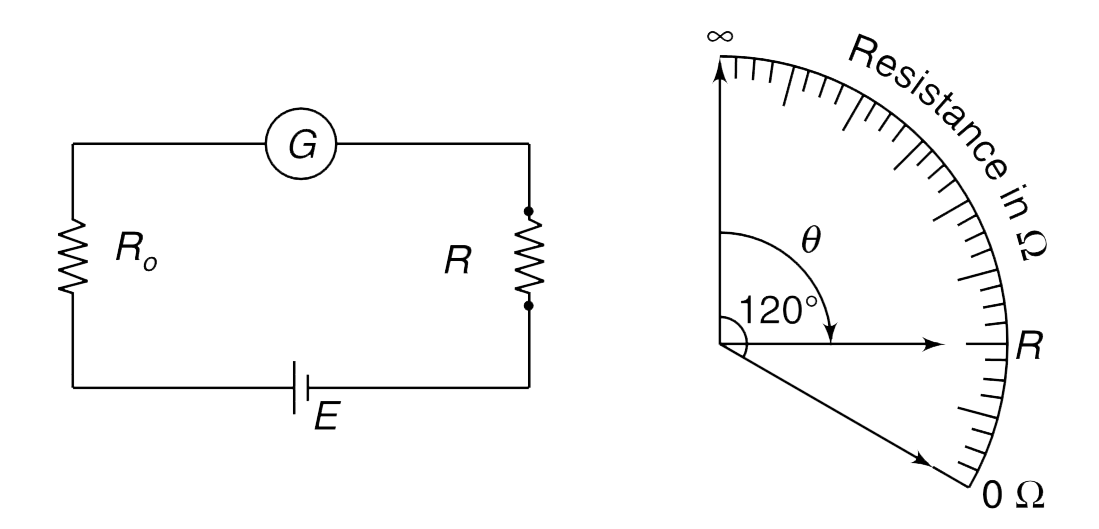In a balanced wheat stone bridge, current in the galvanometer is zero. If remains zero when-
(1) battery emf is increased
(2) all resistance are increased by 10ohms
(3) all resistance are made five times
(4) the battery and the galvanometer are intercharged
only (1) is correct
(1),(2) and (3) are correct
(1),(3) and (4) are correct
(1) and (3) are correct
The correct Answer is:C
To solve the problem, we need to analyze the conditions under which a Wheatstone bridge remains balanced. A Wheatstone bridge is balanced when the ratio of the resistances in one branch is equal to the ratio of the resistances in the other branch, which can be expressed as:
PQ=RS
Where P, Q, R, and S are the resistances in the bridge.
1. Condition of Balance: In a balanced Wheatstone bridge, the current through the galvanometer is zero. This condition is maintained as long as the ratio of the resistances remains unchanged.
2. Increasing the Battery EMF:
- If we increase the EMF of the battery, it does not affect the ratio of the resistances P, Q, R, and S.
- Therefore, the balance condition PQ=RS still holds true.
- Conclusion: The current in the galvanometer remains zero.
3. Increasing All Resistances by 10 Ohms:
- If we increase each resistance by 10 ohms, the new resistances become P+10, Q+10, R+10, and S+10.
- The new balance condition becomes P+10Q+10≠R+10S+10 (this will not hold true for arbitrary values of P, Q, R, and S).
- Conclusion: The current in the galvanometer will not remain zero.
4. Making All Resistances Five Times:
- If all resistances are multiplied by 5, we have new resistances as 5P, 5Q, 5R, and 5S.
- The balance condition becomes 5P5Q=5R5S, which simplifies to PQ=RS.
- Conclusion: The current in the galvanometer remains zero.
5. Interchanging the Battery and Galvanometer:
- Interchanging the battery and the galvanometer does not affect the balance condition of the Wheatstone bridge.
- The ratios of the resistances remain unchanged.
- Conclusion: The current in the galvanometer remains zero.
Final Results:
- The current in the galvanometer remains zero in the following cases:
- (1) When the battery EMF is increased.
- (3) When all resistances are made five times.
- (4) When the battery and the galvanometer are interchanged.
Thus, the correct options are 1, 3, and 4.
- If we increase the EMF of the battery, it does not affect the ratio of the resistances P, Q, R, and S.
- Therefore, the balance condition PQ=RS still holds true.
- Conclusion: The current in the galvanometer remains zero.
- If we increase each resistance by 10 ohms, the new resistances become P+10, Q+10, R+10, and S+10.
- The new balance condition becomes P+10Q+10≠R+10S+10 (this will not hold true for arbitrary values of P, Q, R, and S).
- Conclusion: The current in the galvanometer will not remain zero.
- If all resistances are multiplied by 5, we have new resistances as 5P, 5Q, 5R, and 5S.
- The balance condition becomes 5P5Q=5R5S, which simplifies to PQ=RS.
- Conclusion: The current in the galvanometer remains zero.
- Interchanging the battery and the galvanometer does not affect the balance condition of the Wheatstone bridge.
- The ratios of the resistances remain unchanged.
- Conclusion: The current in the galvanometer remains zero.
- The current in the galvanometer remains zero in the following cases:
- (1) When the battery EMF is increased.
- (3) When all resistances are made five times.
- (4) When the battery and the galvanometer are interchanged.
Similar Questions
Figure shows a balanced Wheatstone's bridge

(1) If P is slightly increased, the current in the galvanometer flow from A to C.
(2) If P is slightly increased, the current in the galvanometer flows C to A.
(3) If Q is slightly increased, the current in the galvanometer flows from C to A.
(4) If Q is slightly increased, the current in the galvanometer flows from A to C.
View SolutionIf the current current sensitivity of a moving coil galvanometer is increased by 20%, its resistance also increases by 1⋅5 times. How will the voltage sensitivity of the galvanometer be affected?
View Solution
Knowledge Check
The initial rate of increase of current, when a battery of emf 6 V is connected in series with an inductance of 2 H and resistance 12Ω , is
A0.5As−1B1As−1C3As−1D3.5As−1Voltage range of galvanometer of resistance R is 0 to 1V. When its range increases upto 2V for this the additional resistance required in series will be
ARB2RC3RD4RIf all resistors in the shown network are of equal resistance, and the battery is of emf equal to 10 V and internal resistance equal to 1Ω, what should be resistance of each resistor so that the battery delivers maximum power
 A1ΩB2OmeggaC3ΩD4Ω
A1ΩB2OmeggaC3ΩD4Ω
An ohm-meter is a device that measures an unknown resistance. A simple ohm-meter can be constructed using a galvanometer as shown in the figure. The cell used in the circuit has emf E=20 volt. The full scale deflection current and resistance of the galvanometer are 2mA and 20Ω respectively. R0 is a fixed resistance and R is the unknown resistance whose value is directly given by the galvanometer scale. The galvanometer scale is shown in figure. When an unknown resistance R is placed in the circuit, the pointer deflects by θ=90∘. Find R.

View SolutionA galvanometer, together with an unknown resistance in series, is connected across two identical batteries of each 1.5V. When the batteries are connected in series,the galvanometer records a current of 1A, and when the batteries are connected in parallel, the current is 0.6A. In this case, the internal resistance of the battery is 1/'∗'Ω.
What is the value of '**'?
View SolutionA car has a fresh storage battery of emt 12V and internal resistance 5.0×10−2Ω. If the starter moter the battery when the starter is on?
(b) After long use, the internal resistance of the storange battery increase to 500Ω. What maximum current can be drawn from the battery? Assume the emt of the battery to remain unchanged.
(c) If the discharged battery is changed by an external emf source, is the terminal voltage of the battery during changing greater of less than is emf 12V?
View SolutionWhen a resistance of 2 ohm is placed across a battery the current is 1 A and when the resistance across the terminals is 17 ohm, the current is 0.25A. The emf of the battery is
View SolutionWhen a battery of emf 2 V is directly connected to a galvanometer of resistance 100Ω. It shows full scale deflection. To measure 1 A current , the shunt must be
View Solution